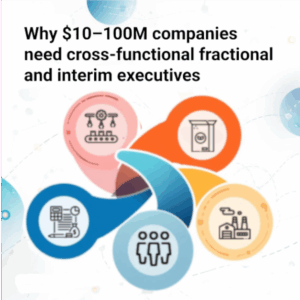Why $10–100M companies need cross-functional fractional and interim executives

Most founders/CEOs of companies between $10M and $100M think their problems sit neatly in one bucket:
- 📉 If sales are slow, it’s a marketing problem.
- 💸 If margins are tight, it’s an operations problem.
- 🕒 If delays keep happening, it’s a manufacturing problem.
⚠️ But the truth? Those buckets are intrinsically linked.
It’s not as simple as “a marketing push spikes demand the factory can’t handle.” Real growth is about mid-to-long-term planning. When a company invests in brand and packaging, it isn’t chasing a short-term spike—it’s changing its trajectory. That means projecting increased capacity, reengineering processes and equipment, and finding ways to leverage that volume to reduce COGS.
💥 Here’s the kicker: a packaging redesign might trigger millions in CAPEX. That requires leadership that can zoom out and connect the dots—equally fluent in brand positioning, operational efficiency, and manufacturing bottlenecks. The job is turning what would otherwise be conflicting priorities into a unified growth plan.
This is where a multi-functional fractional or interim executive is different. Traditional fractional roles tend to land in one lane—an interim COO to stabilize operations, a fractional CMO to drive sales, a CFO to tighten up the numbers. But in a sub-$100M, even more so the smaller the company, problems don’t sit in silos. A multi-functional leader looks at the entire system—how a brand decision impacts manufacturing, how an ops fix shapes margins, how supply chain changes ripple into customer experience. They bridge what’s usually disconnected, balancing tactical fire-fighting with strategic foresight.
The best multi-functional COOs operate as a true partner to the founder/CEO. Their incentives are aligned, their perspective is complementary, and their work is hands-on—not advisory from the sidelines. They’re in the trenches providing leadership and enabling the founder/CEO to focus on what’s most important to the company (which is almost always sales and investor relations). That’s why these roles create leverage far beyond what a single-discipline interim executive can deliver.
Companies of this size can’t (and shouldn’t) spend budget on redundancy, bloated org charts, layers of specialized VPs or siloed decision-making. What they need are multi-functional executives, not hammers who see every problem as the same nail, but leaders who align brand, operations, and manufacturing into one trajectory of growth. That’s how $10M companies become $100M companies.